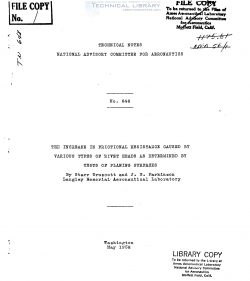naca-tn-648
- Version
- 123 Downloads
- 628.02 KB File Size
- 1 File Count
- November 28, 2016 Create Date
- November 28, 2016 Last Updated
National Advisory Committee for Aeronautics, Technical Notes - The Increase in Frictional Resistance Caused by Various Types of Rivet Heads as Determined by Tests of Planing Surfaces

The increase in the frictional resistance of a sur—
face caused by the presence of rivet heads was determined
by towing four planing surfaces of the same dimensions in
the N.A.C.A. tank. One surface was smooth and represented
a surface without rivet heads or one with perfectly flush
countersunk rivets. The other three surfaces were each
fitted with the same number of full—size rivet heads but
of a different type arranged in the same pattern on each
surface. The surfaces were towed at speeds representative
of the high water speeds encountered by seaplanes during
take—off and the range of Reynolds Number covered by the
tests was from 4 x 106 to 18 x 105.
The rivet heads investigated were oval countersunk,
brazier, and round for rivets having shanks 5/32 inch in
diameter. The oval countersunk heads were sunk below
the surface by dimpling the plating around them.
The results of the tests showed that, for the rivet
heads investigated, the increase in the friction coeffi-
cient of the surface is directly proportional to the
height of the rivet head. The order of merit in regard
to low resistance is flush countersunk, oval countersunk
(whether sunk below the surface or not), brazier, and
round.
The use of projecting rivet heads on metal seaplane
floats and hulls increases the roughness, and hence the
frictional resistance, of the surface. On the other hand,
the use of countersunk heads to maintain a smooth surface
increases the cest of construction, particularly with thin
plating. It is therefore desirable, where the take-off
performance is an important consideration, to know the
relative hydrodynamic resistance caused by various standu
ard rivet heads at the water speeds to be encountered.
An investigation to obtain this information was made
in the N.A.C.A. tank for the Bureau of Aeronautics of the
Navy Department. Full—size standard rivet heads for riv—
ets with a shank 5/32 inch in diameter were fitted to
planing surfaces and the_surfaces were towed at speeds up
to 40 miles per hour. The results therefore apply direct—
1y to a typical portion of the fully immersed bottom of a
hull traveling at these speeds.
| File | Action |
|---|---|
| naca-tn-648 The Increase in Frictional Resistance Caused by Various Types of Rivet Heads as Determined by Tests of Planing Surfaces.pdf | Download |
Comment On This Post